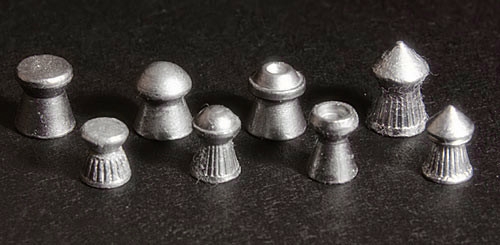Cartridge Cases or Shells
The cartridge cases or the shells house the primer, the propellant, the wads, if any, and the projectile charge. They are manufactured from a variety of materials: brass, paper, aluminium, steel and plastics are currently being used. The paper cartridge cases with brass base are commonly used in India, for shotgun cartridges. The Indian Ordnance Factories have also started manufacturing cartridge cases with plastic tubes.
In USA the paper shells have been replaced, almost completely, by plastic shells, though the brass base for the shell continues. The brass shells for rifle, pistol and revolver ammunition are, by far, the commonest. It is believed that plastics and aluminium will find ever-increasing use for the shell manufacture as long as the caseless cartridge does not displace the other cartridges. From the practical point of view only two types of cartridge cases are important in our country, at present. They alone will be reviewed here, briefly.

1.1 Shotgun Shell A shotgun shell consists of a tube, a base and a base wad. The tube is ordinarily made of many layers of impregnated thin paper which are tightly compressed. The ultimate tube is sufficiently strong to withstand the pressure (800 kg/cm²), developed in the cartridge. It is also made waterproof.
The shotgun shells are usually made into two lengths:
1. 2.5″ (= 63.5 mm)
2. 2.75″ (= 70 mm)
The base is made of brass. The process of manufacturing the brass bases (cartridge head) is similar to the one used for the manufacture of percussion caps or brass shells. The base wad is made of many layers of paper. The brass base, base wad and the tube are placed together in a die and crimped together to create a rim which holds them together. The rim of the brass head ensures proper hold of the base wad and the paper tube. The hold is sometimes additionally strengthened by circular grooves around the tubular portion of the brass head. The rim also retains the cartridge in the chamber properly.
The base wad strengthens the cartridge cases. It also serves as a filler in dense powder ammunition. Sometimes a circular steel strip is put in between the base wad and the brass head for additional strengthening of the system.
Other facts about shotgun shells which may be useful, are:
1. There are low and high brass bases. In India usually low brass bases are used. High brass bases are met with. They are used in Magnum cartridges – which have more powder and projectile charge. They may or may not have higher velocities.
2. If the cushion wad does not seal the barrel, part of the gases will escape and heat up the pellets to melt and fuse them. These molten projectiles would not give the intended ballistics.
3. The projectiles which come in contact with the barrel may get deformed (due to friction and pressure). They may go astray in their flight, once they are out of the barrel.
4. Over shot wads interfere a little with the dispersion of the pellets by getting into their way after it had come out of the barrel.

1.2 Brass Shell
Brass (copper 70%, zinc 30%) has been found a particularly good material for the manufacture of shells. It is the main material used in the manufacture of shells for rifles, pistols and revolvers ammunition on a large scale. This is because the alloy is easy to work with: stamped, drawn and annealed. Besides, it is resistant to corrosion and action of weather. It has sufficient elasticity to fill the chamber under pressure (obturation) and come back to original size after the pressure released. Brass of high quality and purity only is used for the purpose.
The brass shells are now manufactured by automatic process involving about two scores of operations. It starts with a sheet of brass of appropriate thickness. A disc of desired diameter is punched out. The disc is stamped to give a shell after a number of stamping, heating, annealing and drawing operations. The cartridge cases may be rimmed, semi-rimmed, rimless belted. They may be straight, tapered or bottle-necked.
Wads
In shotgun ammunition, there are various types of wads. Over-powder wad, cushion-wad, under-shot wad and over-shot wad. They keep the part of the ammunition in the cartridge in their proper places.
The cushion wads are about 12.5 mm thick and are greased. The grease lubricates the barrels.
The modern shotgun wadding has undergone a sea change in the last few decades. The following changes have been made:
1. The base wad is a plastic mould and fixed in the base of the brass head, under pressure.
2. The over-powder wad has converted to an inverted cup wad-open side towards (and over) the powder, so that when gases are formed, the lip, the open round edge of the cup, is pressed with the pressure against the barrel and thus it seals the bore. It prevents the escape of gases from the sides.
4. The buckshots in a cartridge, have spaces which are filled with granular plastic material to cushion the buck shots which prevents damage and provides uniform push to the projectiles.
Indian Ordnance Factory has introduced similar wads in their cartridges. In rifle, pistol and revolver ammunition, ordinarily, no wad is used, but in some cases a small wad over the powder charge is provided. It separates the powder charge from the projectile. It prevents the lubricating grease placed in the cannelure to seep inside and spoil the powder charge. Besides, it seals the bore and decreases escape of gases.
Lubricants
Bullets are lubricated to reduce friction and prevent oxidation of the cases or projectiles. The purpose was formerly achieved either by external lubrication or internal lubrication. In the former, the bullets were covered with a layer of bees wax. These bullets tended to collect sand, dust and dirt. The technique is not favoured now. In internal lubrication, bees-wax was placed in the cannelures of the bullet. The cannelures were covered in the cartridge case. Jacketted bullets ordinarily do not have any lubricant.
For more updates, subscribe this blog.







